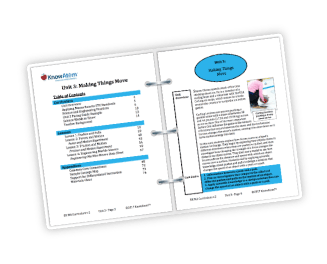The science background provides teachers with more in-depth information on the phenomena students explore in this unit. Below is an excerpt from the science background section on the cell membrane.
Cell Membrane Structure and Function
The cell membrane of both eukaryotes and prokaryotes holds all of the organelles inside the cell and keeps unwanted molecules outside the cell. The cell membrane is less like a hard shell and more like a skin that has many pores.
The cell membrane is semi-permeable (pronounced sem-ee- puhr-mee-uh-buhl) because it allows some molecules through but blocks out others. Molecules that are large or unknown are usually blocked by the cell membrane to protect it. In contrast, water flows in and out of cells easily because the cell membrane has pores large enough for water to travel through. Nutrients also must pass through the cell membrane to nourish the cell.
The ability of water to flow into and out of the cell is essential to the cell’s survival. All cells need to maintain a balanced concentration of water and dissolved particles, called solutes. If the concentration of water to solutes is unequal, water will move from the area of its highest concentration to the area of lowest concentration until the concentrations are equal.
This balancing of water and solutes happens through the process of osmosis. Osmosis is the diffusion of water across a semi-permeable membrane. Osmosis only happens when there are more solutes on one side of the cell membrane than on the other side, and when the membrane is permeable to water but impermeable to the solute. Impermeable means it blocks the solutes.
During osmosis, water moves from an area of high water concentration to an area of low water concentration. An area has a high water concentration when it has few solutes such as salt compared to the amount of water. An area has a low water concentration if it has less water and more solutes. This means that water will move toward the side of the cell membrane where there are more solutes because there is less water there. In other words, water “follows” the particles to decrease their concentration.
Osmotic pressure describes pressure caused by the particles that are unable to cross the cell membrane. Water flows from the solution with the lower solute concentration (low osmotic pressure) into the solution with higher solute concentration (high osmotic pressure). Equilibrium is reached when enough water has moved to balance the solute concentration on each side of the cell membrane.
The health and survival of plants and animals depends on the ability of their cells to maintain a balanced concentration of water and solutes.
A Cell’s Tonicity
If a plant or animal cell is placed in a solution containing water, osmosis will cause one of three things to happen, depending on the solution’s tonicity—the measure of water lost or gained from osmosis.
1. The cell will remain the same if the solution surrounding the cell has the same water/solute concentration as the cell. In this case, the solution is isotonic.
2. The cell will gain water (and therefore mass) if the solution surrounding the cell has a higher water concentration than the cell. In this case, the solution is said to be hypotonic because there are fewer solutes in the solution than in the cell. This flow of water into the cell will cause the cell to expand. Too much water in an animal cell can cause the cell to expand so much it bursts. The cell wall in plant cells prevents them from bursting.
3. The cell will lose water (and therefore mass) if the solution surrounding the cell has a lower water concentration. In this case, the solution is hypertonic because there are more solutes in the solution than in the cell, causing the cell to shrink.



.png?width=200&height=263&name=Screenshot%20(43).png)
.png?width=200&height=263&name=Screenshot%20(44).png)
.png?width=200&height=261&name=Screenshot%20(45).png)
.png?width=323&height=350&name=Screenshot%20(47).png)



